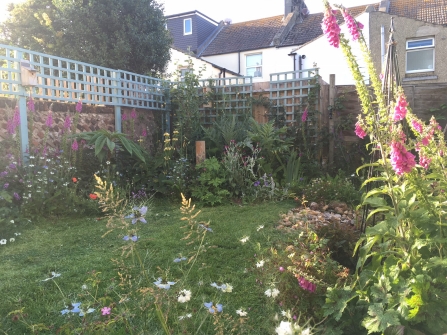I’ve recently moved into a new house. The garden is larger than the one I had previously, but it was planted up with non-native, non-flowering plants and shrubs – Japanese spindle, eucalyptus, cordyline and palm trees. It took ages for me to see my first bee of the year because so few were coming into the garden. But they eventually turned up – because I planted flowers for them.
As I write, hairy footed flower bees are nectaring on the lungwort I planted in the front garden, while bumblebees feast on primroses, pussy willow and apple blossom. As the year progresses more of what I’ve planted will flower for bees and other pollinators – borage, alliums, viper’s bugloss, lavender, hyssop, catmint, poppies. Bees feed nectar and pollen to their young but the larvae of moths, butterflies and hoverflies will also be well catered for in the garden. Moths and butterflies lay eggs on plants and their caterpillars eat leaves and flower shoots – they’ll find plenty to eat from the silver birch, hawthorn, elder, buckthorn and nettles I’m growing. The larvae of most hoverflies eat aphids. By not removing these from my plants I’ll ensure there’s plenty of food for them to eat.
Helping bees and other pollinators in the garden is easy and makes a huge difference to their populations. I’m so proud to be involved with The Get Dorset Buzzing Campaign, which is designed to help Dorset improve habitats for pollinators such as bees, butterflies, moths and pollinating beetles. By signing up and pledging your support, you can learn more about certain species likely to visit your garden, learn about the flowers and other plants needed to help them complete their lifecycles, and receive regular email updates with interesting facts and other snippets about gardening for pollinators.
You don’t need a large garden to take part, or even a garden at all! By simply growing a few nectar- and pollen-rich plants, such as those I listed above, in a container or window box, you can make a difference to pollinating species.
Is your garden good for pollinators?
Is your garden teeming with bees or quiet, like mine was before I planted flowers? Perhaps the first thing you can do to help is to take stock of your garden and the plants growing in it. Do you have something in flower every month of the year, or is it largely green, with plants like palm trees and cordylines taking up space but not providing food for pollinators? Once you have worked out what you do have, then you can add pollinator plants to fill in the gaps.
The cheapest and quickest way to provide an extra source of pollen and nectar is to sow tender annuals such as cornflower, field poppy, scabious, love-in-a-mist and calendula now. You can also sow seeds of borage and honeywort, which provide masses of pollen and nectar for pollinators. Invest in a few small shrubs such as lavender, oregano and rosemary – you don’t need to buy large specimens, the small ones establish better when planted and quickly grow.
And what about caterpillar foodplants? The larvae of butterflies and moths feed on leaves – many of our most treasured butterfly species, such as the small tortoiseshell, peacock and red admiral, lay eggs on nettles, while many moth species lay eggs on the leaves of native shrubs and trees, such as hawthorn, birch and hazel. Allowing weeds to flourish in a corner of your garden can also help moths and their caterpillars – the larvae of many species, including the wonderful garden tiger, feed on nettles, dock, burdock and dandelion.


